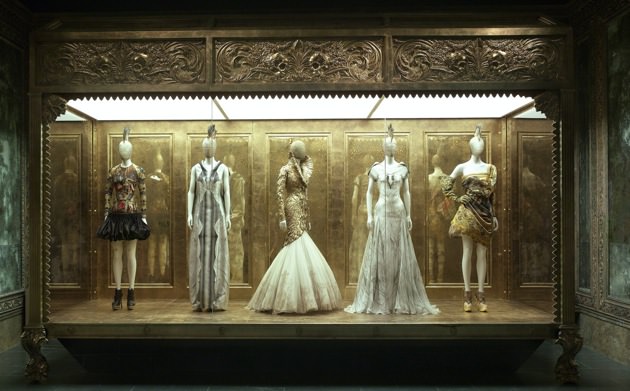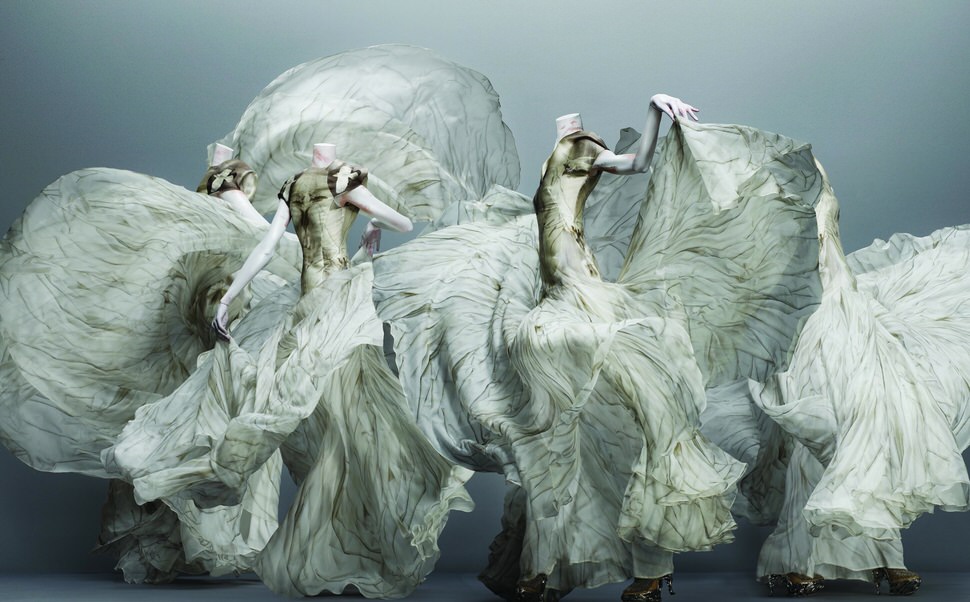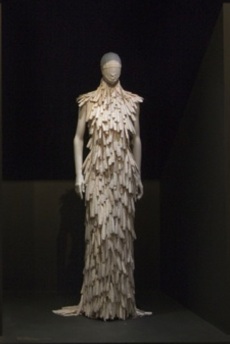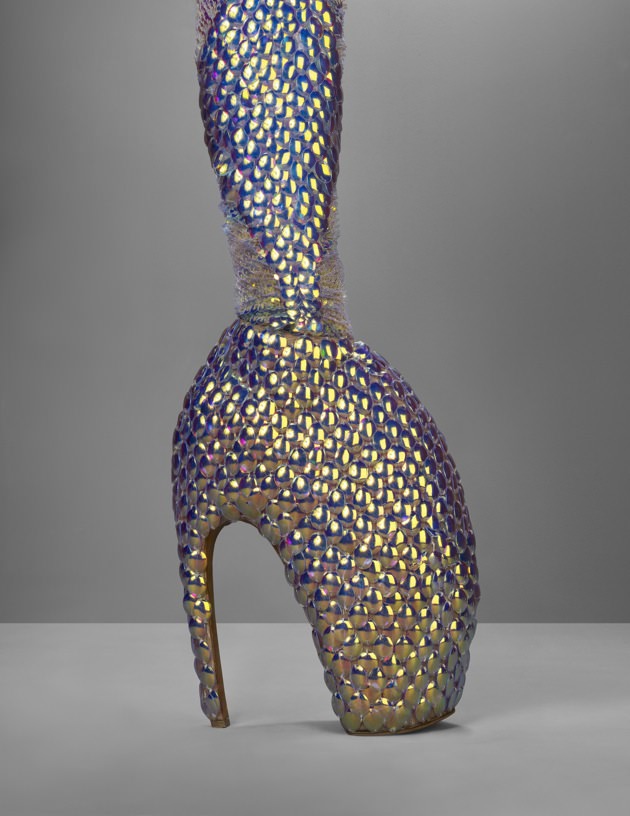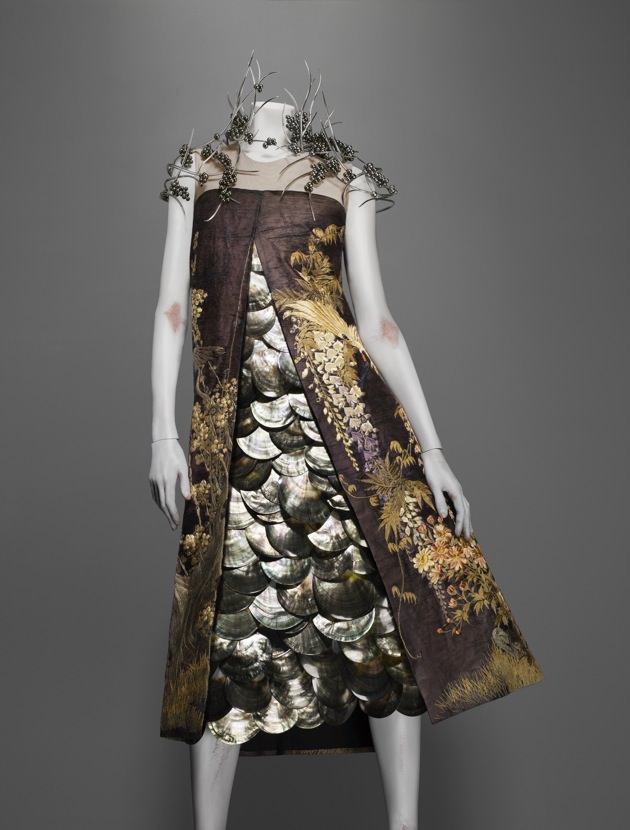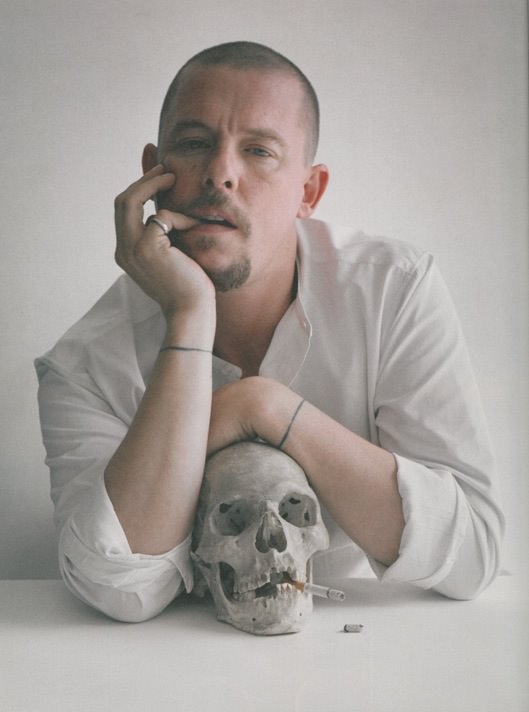Nearly twenty-five years ago I was called into the office of Anna Wintour, my boss during her brief interregnum at House & Garden magazine before she ascended to fashion glory as editor-in-excelsis of Vogue. “You use too many adjectives,” she told me. “I don’t like adjectives. That’s all.” But I now wonder how one could possibly explain the peculiar and pathological art of Alexander McQueen (whose most powerful promoter has been Wintour) without recourse to many multiple modifiers?
Alexander McQueen: Savage Beauty, the Metropolitan Museum of Art’s memorial tribute to the British fashion designer who died by his own hand in February 2010, is surely the most stupendous exhibition ever mounted by the Met’s Costume Institute. By rapid and random turns it is breathtaking, creepy, decadent, dreamlike, fetishistic, grandiose, grotesque, hilarious, infantile, majestic, meretricious, nightmarish, perverse, ponderous, ridiculous, sentimental, stately, tawdry, touching, and wondrous, often in contradictory combinations of those traits.
The show establishes beyond refutation that McQueen was some kind of genius, though precisely what sort is harder to say. Unquestionably he ranks as a consummate tailor, as seen in the stunning enfilades of flawlessly cut coats, jackets, trousers, and dresses, mainly in black, that occupy the first of the show’s seven operatically staged galleries.
The severity of line and exactitude of construction that he learned as a teenaged apprentice on London’s Savile Row were later softened by the delicate craftsmanship he picked up from the petites mains of Paris haute-couture, after the luxury-goods conglomerate LVMH in 1996 chose this twenty-seven-year-old working-class Londoner to head the eponymous fashion house founded four decades earlier by the impossibly grand Hubert de Givenchy The dialectic between those two very different but equally demanding fabrication methods gave McQueen a technical ability unsurpassed by any of his present-day peers.
One can only gaze in open-mouthed awe at pieces in the Met show such as an ivory silk organza evening dress that is a veritable tornado of complex ruffles. You can’t help but think of the many-breasted Diana of Ephesus while regarding a frock encrusted from neck to toe with hundreds of phallic razor-clam shells, or marvel at the intricate workmanship of a diagonally-tiered mid-length cream silken lace skirt that hangs from a sutured brown-leather torso carapace, which in turn recalls a prosthetic on a George Grosz Kriegsinvalide.
The Met show has been an instantaneous sensation, breaking attendance records for the Costume Institute. Its popularity was boosted by the coincidence of its opening gala, three nights after the British royal nuptials, and Catherine Middleton’s choice of a wedding dress by Sarah Burton, who took over as creative director of McQueen’s London atelier soon after the founder’s death. Burton’s conservative though impeccably executed design looks dowdier each time one sees it, but if we could hardly have expected a flight of fevered fancy equal to her mentor’s twisted visions of Romantic rapture, the global chatter provoked by Middleton’s tidy little marital McQueen was enough to guarantee the Met show a succès fou.
The current exhibition displays nearly 100 outfits and fifty accessories, the cumulative effect of which is akin to a tasting menu of nothing but variations on foie gras. This almost nauseating surfeit of richness is nonetheless appropriate for McQueen, who disassociated the thoroughly impractical and largely unwearable fantasies of his couture runway shows from his ready-to-wear offerings, and made those twice-yearly high-end presentations into high-concept performance art. (This fact has not been lost on such followers as Lady Gaga, who has worn McQueen’s Jellyfish ensemble and Armadillo boots—both covered in iridescent enamel paillettes— in her stage act and Bad Romance music video.)
Permeating this go-for-broke extravaganza—intelligently curated by the Met’s Andrew Bolton and spectacularly installed by Sam Gainsbury and Joseph Bennett, the ingenious production designers who orchestrated McQueen’s runway shows — are twin hallmarks of the subject’s sensibility: excess (both wretched and glorious) and obsessiveness (which gives many of his creations the manic over-elaboration of art by the mentally ill). For sheer sumptuary extravagance nothing on view here tops an ensemble from the VOSS collection, with an overdress made of panels taken from a nineteenth-century Japanese silk screen and an underdress of oyster shells, topped off with the jeweler Shaun Leane’s devouring neckpiece of silver and Tahitian pearls. For mad micro-detailing that can make your eyes cross, the dense Egyptoid embroidery on a mini-dress from the Scanners collection puts King Tut’s haberdashers to shame.
Advertisement
There are also several frankly disgusting sub-themes that run through the exhibition like open sewage ditches among Le Nôtre’s parterres at Versailles. If McQueen was the Mapplethorpe of fashion, it was not only for his similarly humble origins, homosexuality, taste for S&M, soaring ambition, ferocious opportunism, driven perfectionism, dogged work ethic, coke-fueled creative jags, and death at an early age , but also because of the rather puerile delight he took in seeking to shock the high bohemians who lionized him. Bad boys apparently never go out of fashion.
The front cover of the exhibition catalog takes a page straight out of the Mapplethorpe playbook: a plastic lenticular panel features a frontal headshot of the designer (by his nephew Gary James McQueen) that, when moved, morphs into a chrome-plated skull. McQueen’s sadomasochism is alluded to in several of his quotes in the exhibition’s wall texts and obvious in his appropriation of painful-looking torture paraphernalia—leather restraint masks, multi-buckled harnesses, and a metal crown-of-thorns— that might be found in a bondage-and-discipline boutique.
More profoundly disturbing is McQueen’s undeniable misogynistic streak, displayed in dresses and shoes that bind and hobble; repeated references to women being stabbed, sliced, and diced (and occasionally reassembled); women as impassive sex dolls; and videos showing models being burned at the stake, forcibly abducted, or in sundry states of extreme physical and psychic distress. Among the most unpleasant of these coups de théâtre, his Fall 1998 couture collection, entitled Joan, climaxed with an all-too-lifelike re-enactment of The Maid of Orleans going up in flames. McQueen became defensive when accused of glamorizing anti-female violence, but no amount of rationalization can contradict what our eyes tell us.
To be sure, the deeply troubled McQueen—whose volatile mixture of anger, hurt, solipsism, and disinhibition is recognizable to anyone who has dealt with substance abuse at first or second hand— was inclusively misanthropic, and little of humanity was exempt from his free-floating rage. But when the primary consumers of your work are female, there is legitimate cause to question designs that seem hostile to women.
The most damning evidence of McQueen’s ruthless careerism and monumental self-absorption concerns his appalling treatment of Isabella Blow, the fashion stylist and magazine editor who discovered him. Blow was so mesmerized by the collection McQueen created for his graduation from London’s Central St. Martins College of Art and Design in 1992—a Victorian-themed presentation he called Jack the Ripper Stalks his Victims—that she bought all fourteen ensembles (two of which are included in the Met show.)
The pair became close friends, vacationed together, and Blow is said to have engineered the lucrative sale of his fledgling business to the Gucci Group in 2000, which made him rich. Yet the designer seems to have abandoned the emotionally vulnerable, always hard-up Blow when he was in a position to rescue her financially. As the socialite Daphne Guinness, another McQueen devotee, told The New York Times, “She was upset that Alexander McQueen didn’t take her along when he sold his brand to Gucci. Once the deals started happening, she fell by the wayside. Everybody else got contracts, and she got a free dress.”
Blow, a chronic depressive who had been diagnosed with ovarian cancer, committed suicide in 2007, three years before McQueen—who was distraught over the death of his adored mother and under treatment for depression—took an overdose of drugs and hanged himself in his Mayfair flat.
McQueen was in, on top of, and out of this world in only forty years, and moved at warp speed from enfant terrible to poète maudit to monstre sacré. His clamorously received Met retrospective now ratifies his final incarnation, that of tragic culture hero.
Alexander McQueen: Savage Beauty is on view at the Metropolitan Museum of Art through August 7.


